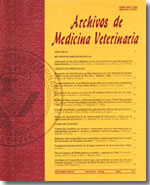Epidemiological studies on infective larvae of gastrointestinal nematodes on pasture grazed by alpacas (Lama pacos) in Valdivia, Southern Chile
Main Article Content
Abstract
In order to study the epidemiology of Trichostrongylid parasites in alpacas (Lama pacos), a study was undertaken in Valdivia, Chile, Xth Region (39º 48’ S, 73º 14’ W) based on faecal and grass examinations, during a period of fifteen months, starting in January 1995. Animal were grouped according to the age as follows: Group A, 4 animals up to one year old; group B, 11 animals between 1 to 2 years old and 32 animals more than 2 years old.
The most frequent genus or species of infective larvae identified were: Nematodirus spathiger, Ostertagia, Trichostrongylus, Nematodirus filicollis and Cooperia.
During the 1995 summer, a low number of infective larvae were observed as a consequence of the low contamination of the grass during the previous year, and to the dry period in the summer months. In autumn, larvae increased reaching a peak in April with 447 larvae per Kg dry matter. The greatest contribution was given by N. spathiger. The other species were less frequently identified.
Strongylid type eggs, Nematodirus, Trichuris sp. and Capillaria sp. were observed, few eggs were seen during the observation period. Related with Strongylid type eggs, more eggs were seen in group A. Related with Nematodirus eggs, few eggs were seen in group B and C. More eggs were seen in group A. Trichuris sp. and Capillaria sp. eggs were less frequently observed.
It can be concluded that: weather conditions influence the number of infective larvae on the grass. Strongylid egg number are low as a consequence of the deposition of faeces in particular sites.

